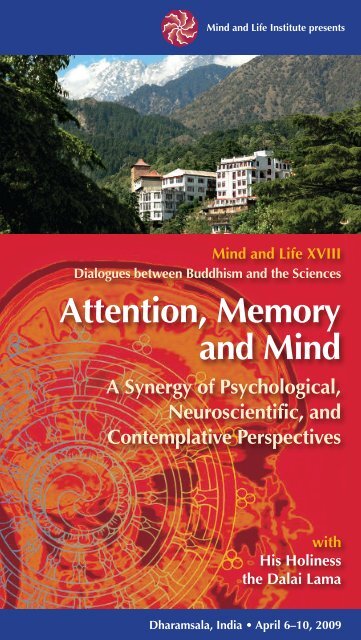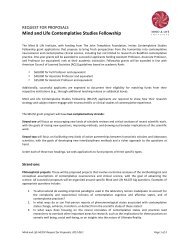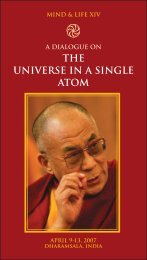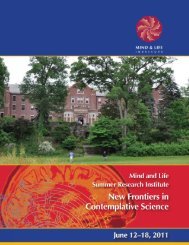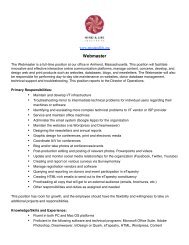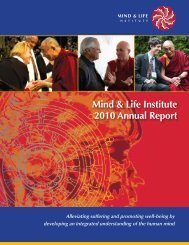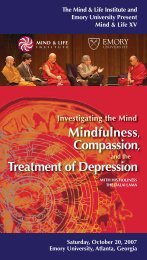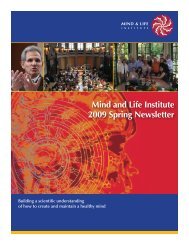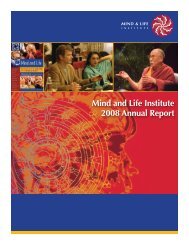to view the brochure from the conference (PDF). - Mind & Life Institute
to view the brochure from the conference (PDF). - Mind & Life Institute
to view the brochure from the conference (PDF). - Mind & Life Institute
You also want an ePaper? Increase the reach of your titles
YUMPU automatically turns print PDFs into web optimized ePapers that Google loves.
<strong>Mind</strong> and <strong>Life</strong> <strong>Institute</strong> presents<br />
<strong>Mind</strong> and <strong>Life</strong> XVIII<br />
Dialogues between Buddhism and <strong>the</strong> Sciences<br />
Attention, Memory<br />
and <strong>Mind</strong><br />
A Synergy of Psychological,<br />
Neuroscientific, and<br />
Contemplative Perspectives<br />
with<br />
His Holiness<br />
<strong>the</strong> Dalai Lama<br />
Dharamsala, India • April 6–10, 2009
INTRODUCTION<br />
The <strong>Mind</strong> and <strong>Life</strong> Dialogues<br />
and <strong>the</strong> <strong>Mind</strong> and <strong>Life</strong> <strong>Institute</strong><br />
Beginning in <strong>the</strong> twentieth century, science has become <strong>the</strong> dominant paradigm for<br />
understanding <strong>the</strong> natural world by way of objective, quantitative measurements,<br />
using <strong>the</strong> instruments of technology. The integration of scientific knowledge and<br />
technology has vastly contributed <strong>to</strong> our understanding of <strong>the</strong> physical world and <strong>to</strong><br />
improving <strong>the</strong> human standard of living. Fur<strong>the</strong>rmore, over a much longer time<br />
period spanning <strong>the</strong> past 2,500 years, Buddhism has emerged in multiple cultures<br />
throughout Asia as <strong>the</strong> dominant paradigm for understanding <strong>the</strong> natural world by<br />
way of subjective, qualitative observations by way of highly sophisticated meditative<br />
training. The integration of Buddhist <strong>the</strong>ories and practices has revealed many<br />
important insights in<strong>to</strong> <strong>the</strong> nature of <strong>the</strong> mind and its role in nature, while radically<br />
transforming and enriching its host societies and improving <strong>the</strong> quality of life of its<br />
adherents. In many ways, <strong>the</strong> methods and goals of scientific and contemplative<br />
inquiry are profoundly complementary, with each of <strong>the</strong>m having enormous potential<br />
for enriching <strong>the</strong> o<strong>the</strong>r.<br />
In 1987, recognizing that <strong>the</strong>re was no official orderly way for science and Buddhism<br />
<strong>to</strong> share <strong>the</strong>ir findings, and convinced that a rigorous scientific dialogue and collaboration<br />
between <strong>the</strong>se two impressive traditions would be beneficial for humanity,<br />
neuroscientist Francisco Varela and entrepreneur Adam Engle started <strong>the</strong> <strong>Mind</strong> and<br />
<strong>Life</strong> Dialogues with His Holiness, <strong>the</strong> Dalai Lama. Since <strong>the</strong>n, <strong>the</strong> <strong>Mind</strong> and <strong>Life</strong><br />
meetings have focused on a broad set of <strong>the</strong>mes ranging <strong>from</strong> <strong>the</strong> mind sciences and<br />
biology <strong>to</strong> physics and cosmology. This present meeting on attention, memory, and<br />
<strong>the</strong> phenomenological study of <strong>the</strong> mind is <strong>the</strong> eighteenth such <strong>Mind</strong> and <strong>Life</strong><br />
dialogue.<br />
What sets <strong>the</strong> <strong>Mind</strong> and <strong>Life</strong> dialogues apart <strong>from</strong> o<strong>the</strong>r meetings between science<br />
and Buddhism is <strong>the</strong> focus on in-depth, cross-cultural dialogue. In this meeting, <strong>the</strong><br />
morning presentations by cognitive scientists will be 60-90 minutes in duration,<br />
followed by up <strong>to</strong> 90 minutes of discussion; and <strong>the</strong> afternoon sessions by cognitive<br />
scientists and Buddhist scholars and contemplatives will be 30-45 minutes in<br />
duration, with <strong>the</strong> rest of <strong>the</strong> two hours devoted <strong>to</strong> discussion. These discussions have<br />
always been <strong>the</strong> central focus of each <strong>Mind</strong> and <strong>Life</strong> meeting, and in this <strong>conference</strong><br />
<strong>the</strong>y will play a more predominant role than ever before.<br />
In addition <strong>to</strong> <strong>the</strong> <strong>Mind</strong> and <strong>Life</strong> dialogues and publications, <strong>the</strong> <strong>Mind</strong> and <strong>Life</strong><br />
<strong>Institute</strong> has two o<strong>the</strong>r programs <strong>to</strong> advance our mission:<br />
• The <strong>Mind</strong> and <strong>Life</strong> Summer Research <strong>Institute</strong> is an annual week-long “Science<br />
Retreat” specifically for scientists, scholars, contemplative practitioners and<br />
philosophers <strong>to</strong> advance <strong>the</strong> fields of collaborative research in neuroscience,<br />
clinical science and education.<br />
• The <strong>Mind</strong> and <strong>Life</strong> Education Research Network is a multi-disciplinary<br />
research network investigating how <strong>to</strong> most effectively bring <strong>the</strong> benefits of<br />
contemplative practice <strong>to</strong> children early in <strong>the</strong>ir lives, especially in an educational<br />
setting.<br />
For more information about our previous <strong>Mind</strong> and <strong>Life</strong> dialogues, publications, and<br />
research networks, please visit our web site: www.mindandlife.org.<br />
2
PROGRAM OVERVIEW OVERVIEW<br />
Attention, Memory, and <strong>the</strong> <strong>Mind</strong>:<br />
A Synergy of Psychological, Neuroscientific,<br />
and Contemplative Perspectives<br />
The <strong>to</strong>pics of <strong>Mind</strong> and <strong>Life</strong> XVIII are human attention, memory, and <strong>the</strong> mind<br />
considered <strong>from</strong> phenomenological (including contemplative), psychological, and<br />
neurobiological perspectives. While <strong>the</strong> relation between attention, memory, and <strong>the</strong><br />
mind is a fascinating area of research in psychological science and neuroscience, it is<br />
also of particular interest and investigation in Buddhism, because it is through <strong>the</strong><br />
contemplative refinement of attention and mindfulness that one explores <strong>the</strong><br />
distinctive characteristics, origins, and potentials of human awareness, of suffering,<br />
and of genuine happiness. In short, <strong>the</strong> contemplative training known as “shamatha”<br />
(meditative quiescence) deals with <strong>the</strong> development and refinement of attention; and<br />
this is <strong>the</strong> basis for “vipashyana” (contemplative insight), which entails methods for<br />
experientially exploring <strong>the</strong> nature of <strong>the</strong> mind and its relation <strong>to</strong> <strong>the</strong> world at large.<br />
Fur<strong>the</strong>rmore, sustained voluntary attention (samadhi) is closely related <strong>to</strong> memory,<br />
because in order <strong>to</strong> deliberately sustain one’s attention upon a chosen object, one<br />
must continue <strong>to</strong> remember <strong>to</strong> do so <strong>from</strong> moment <strong>to</strong> moment, faithfully returning<br />
back <strong>to</strong> refocus on that object whenever <strong>the</strong> mind wanders away <strong>from</strong> it. Likewise, in<br />
Buddhism, <strong>the</strong> faculty of “mindfulness” (smrti) refers not only <strong>to</strong> moment-<strong>to</strong>moment<br />
awareness of present events. Instead, <strong>the</strong> primary connotation of this<br />
Sanskrit term (and its corresponding Pali term sati) is recollection. This includes<br />
long-term, short-term, and working memory, non-forgetful, present-centered<br />
awareness, and also prospective memory, i.e., remembering <strong>to</strong> be aware of something<br />
or <strong>to</strong> do something at a designated time in <strong>the</strong> future. In <strong>the</strong>se ways, <strong>from</strong> a contemplative<br />
perspective, memory is critically linked <strong>to</strong> attention, and both of <strong>the</strong>se mental<br />
faculties have important ramifications for <strong>the</strong> experiential and phenomenological<br />
study of <strong>the</strong> mind, its training, and potential optimization.<br />
The discussions during <strong>Mind</strong> and <strong>Life</strong> XVIII will primarily focus on <strong>the</strong> subjective<br />
phenomenology, information-processing operations, and neural mechanisms of<br />
attention, memory, and conscious awareness <strong>from</strong> both scientific and Buddhist<br />
perspectives. We expect that participants in <strong>the</strong>se dialogues, coming <strong>from</strong> <strong>the</strong> various<br />
disciplines of philosophy, psychology, neuroscience, and Buddhist scholarship and<br />
contemplative practice will especially work <strong>to</strong>ward understanding and incorporating<br />
<strong>the</strong> broad range of each o<strong>the</strong>rs’ ideas and <strong>view</strong>s about <strong>the</strong> <strong>to</strong>pics of this meeting.<br />
Special attention will be focused on <strong>the</strong> distinctive characteristics and interactions of<br />
attention, memory, and metacognition as seen <strong>from</strong> diverse <strong>view</strong>points, including <strong>the</strong><br />
possibility of multiple dimensions of awareness (not limiting <strong>the</strong> discussion <strong>to</strong> <strong>the</strong><br />
familiar categories of <strong>the</strong> conscious and subconscious mind), and <strong>the</strong> relationship<br />
between <strong>the</strong> entire spectrum of human information processing, awareness, and <strong>the</strong><br />
world of experience (Lebenswelt) as a whole. We anticipate that this exploration will<br />
lead <strong>to</strong> fur<strong>the</strong>r systematic plans for ground-breaking empirical and <strong>the</strong>oretical<br />
research on meditation and contemplative practice at <strong>the</strong> interface between science<br />
and Buddhism. Participants will be prepared <strong>to</strong> interact collaboratively <strong>to</strong>ward<br />
developing such an exciting research agenda.<br />
3
PARTICIPANTS<br />
Participants<br />
Tenzin Gyatso, His Holiness, <strong>the</strong> XIV Dalai Lama<br />
Adele Diamond, Ph.D., Professor of Developmental Cognitive Neuroscience,<br />
University of British Columbia, Vancouver, BC, Canada<br />
Shaun Gallagher, Ph.D., Professor of Philosophy and Cognitive Science, University<br />
of Central Florida<br />
Rupert Gethin, Ph.D., Direc<strong>to</strong>r of <strong>the</strong> Centre for Buddhist Studies, University of<br />
Bris<strong>to</strong>l, UK<br />
Amishi Jha, Ph.D., Assistant Professor of Psychology, University of Pennsylvania<br />
David E. Meyer, Ph.D., Professor of Psychology, University of Michigan<br />
Elizabeth Phelps, Ph.D., Professor of Psychology, New York University<br />
Clifford Saron, Ph.D., Assistant Research Scientist, Center for <strong>Mind</strong> and Brain,<br />
University of California, Davis<br />
Anne Treisman, Ph.D., Professor of Psychology, Prince<strong>to</strong>n University<br />
B. Alan Wallace, Ph.D., President, Santa Barbara <strong>Institute</strong> for Consciousness<br />
Studies<br />
Interpreters<br />
Geshe Thupten Jinpa, Ph.D., President of <strong>the</strong> <strong>Institute</strong> of Tibetan Classics in<br />
Montreal<br />
B. Alan Wallace, Ph.D., President of <strong>the</strong> Santa Barbara <strong>Institute</strong> for Consciousness<br />
Studies<br />
Conference Coordina<strong>to</strong>rs<br />
David E. Meyer, Ph.D., Scientific coordina<strong>to</strong>r<br />
B. Alan Wallace, Ph.D., Buddhist coordina<strong>to</strong>r<br />
His Holiness <strong>the</strong> Dalai Lama, Thupten Jinpa, John Dunne and Matthieu Ricard discuss “The Universe in a<br />
Single A<strong>to</strong>m” at <strong>Mind</strong> and <strong>Life</strong> XIV in Dharamsala, India, in April of 2007<br />
4
THE DIALOGUE<br />
Day One<br />
Monday, April 6 – Part I:<br />
Multi-tasking, Meditation, and Contemplative Practice<br />
Dialogue Leader: David Meyer<br />
The subjective phenomena commonly experienced by novice and intermediate<br />
practitioners during Shamatha meditation and o<strong>the</strong>r related types of contemplative<br />
practice suggest that <strong>the</strong>y may be unders<strong>to</strong>od in terms of <strong>the</strong>oretical concepts and<br />
empirical results drawn <strong>from</strong> scientific studies of human multi-tasking. Perhaps<br />
practitioners routinely engage in multi-tasking during <strong>the</strong>ir meditative sessions; while<br />
one of <strong>the</strong>ir tasks involves doing <strong>the</strong> meditation itself, ano<strong>the</strong>r probably involves<br />
performing “<strong>the</strong> task of life”, which is perpetually underway and entails many ongoing<br />
mental activities such as retrospecting, evaluating, imagining, planning, day<br />
dreaming, self moni<strong>to</strong>ring, and so forth. Becoming a skilled practitioner who is better<br />
able <strong>to</strong> maintain focused attention, <strong>to</strong> dispel <strong>the</strong> fog of mind wandering, and <strong>to</strong><br />
transcend mental distractions would <strong>the</strong>n depend on developing new task-scheduling<br />
strategies and mechanisms of cognitive control whereby meditation evolves <strong>to</strong> be a<br />
primary task and “<strong>the</strong> task of life” ceases <strong>to</strong> be even a background secondary task.<br />
What have cognitive psychologists and neuroscientists discovered about <strong>the</strong> nature of<br />
multi-tasking relevant <strong>to</strong> <strong>the</strong>se considerations and prospects Specifically we will<br />
consider <strong>the</strong> inefficiencies of multi-tasking, <strong>the</strong> components of human information<br />
processing that underlie <strong>the</strong>m, <strong>the</strong> roles played by alternative types of scheduling<br />
strategies, <strong>the</strong> contributions due <strong>to</strong> various types of working memory, and <strong>the</strong> sources<br />
of individual differences in <strong>the</strong>se related realms. It will be explained how this<br />
analysis may dovetail closely with some classical Buddhist accounts concerning<br />
stages of skill acquisition in Shamatha meditation, and with principles of optimal<br />
“cross-training” in a variety of contemplative practices <strong>to</strong> maximize <strong>the</strong> rate at which<br />
meditative skill is attained. Questions <strong>to</strong> be discussed include: do any Buddhist sutras<br />
or o<strong>the</strong>r scriptures discuss <strong>the</strong> <strong>to</strong>pic of multi-tasking If so, what do <strong>the</strong>y say about it<br />
Do any of <strong>the</strong> major traditional types of Tibetan Buddhist meditation require or<br />
encourage multi-tasking while <strong>the</strong>y are being practiced Can certain types of<br />
meditation enable people <strong>to</strong> become better at multi-tasking If so, in what ways<br />
Part II:<br />
The Buddhist Contribution <strong>to</strong> First-Person Cognitive Science<br />
Dialogue leader: B. Alan Wallace<br />
The primary methods of <strong>the</strong> modern cognitive sciences for investigating <strong>the</strong> mind are<br />
interrogation of o<strong>the</strong>rs concerning <strong>the</strong>ir subjective experience, behavioral studies,<br />
and brain research. All <strong>the</strong>se methods are indirect methods for understanding <strong>the</strong><br />
mind by way of its verbal and behavioral expressions and neural correlates. Although<br />
<strong>the</strong> direct observation of mental states and processes was prevalent in late 19thcentury<br />
psychology, introspection has been marginalized since <strong>the</strong> early 20th century.<br />
Never<strong>the</strong>less, without relying on first-person report, studies of behavior and <strong>the</strong> brain<br />
alone would yield little if any insight in<strong>to</strong> <strong>the</strong> nature of mental phenomena. While<br />
Buddhism lacks any quantitative behavioral science or neuroscience, it has<br />
developed highly sophisticated methods of introspective inquiry based on <strong>the</strong><br />
refinement of attention and metacognitive skills. These methods allegedly result in<br />
reliable, replicable observations regarding <strong>the</strong> origins, nature, and potentials of<br />
consciousness, as well as <strong>the</strong> inner causes of mental suffering and genuine happiness.<br />
5
PRESENTATION THE DIALOGUE ABSTRACTS<br />
There is <strong>the</strong>refore a potential for <strong>the</strong>se methods of refining and utilizing introspection<br />
<strong>to</strong> be integrated in<strong>to</strong> <strong>the</strong> scientific study of <strong>the</strong> mind in ways that may enrich both<br />
Buddhism and modern science. Questions <strong>to</strong> be discussed include: can introspectionism<br />
complement more “third-person” <strong>view</strong>s in <strong>the</strong> science of meditation What<br />
are some of <strong>the</strong> challenges and promises of such an integration<br />
Day Two<br />
Tuesday, April 7 – Part I:<br />
Mental Processes Underlying Attention,<br />
Visual Perception, and Cognitive Control<br />
Dialogue Leader: Anne Treisman<br />
Attention is a fuzzy concept that we try <strong>to</strong> capture in a variety of forms <strong>to</strong> study it in<br />
<strong>the</strong> lab. The main meaning is <strong>the</strong> selection of relevant information when <strong>the</strong> mind is<br />
overloaded or distracted. One dimension along which attention can vary is <strong>from</strong><br />
sharply focused <strong>to</strong> broadly spread. Each setting may yield different information, <strong>from</strong><br />
<strong>the</strong> detailed structure of an object with focused attention <strong>to</strong> <strong>the</strong> gist of a scene with<br />
more global attention. One set of experimental findings suggest a conclusion that is<br />
not easily available <strong>to</strong> introspection: this is that focused attention plays a role in<br />
binding features (like shape, color, or motion) <strong>to</strong> form integrated objects in visual<br />
perception. It prevents mistakes like seeing a blue shirt when <strong>the</strong> person is actually<br />
wearing a green shirt and blue pants. A similar function may be shown in higher level<br />
conceptual thinking, where attention is needed <strong>to</strong> create and hold more complex<br />
ideas in mind and in working forms of memory.<br />
Is <strong>the</strong> role of attention limited <strong>to</strong> conscious perception and thought, leaving a whole<br />
complex set of implicit processes unaffected, or are <strong>the</strong>re limits and controls also on<br />
what goes on unconsciously Many recent studies of both normal people and patients<br />
with brain damage, for instance, have shown that our behavior and brains can be<br />
affected by cues in <strong>the</strong> environment of which we are quite unaware. Can access <strong>to</strong><br />
unconscious information become easier through training in meditation What o<strong>the</strong>r<br />
effects can meditation training have on attention We <strong>to</strong>ok some standard tests <strong>from</strong><br />
Western psychology and made some preliminary studies of experienced medita<strong>to</strong>rs,<br />
testing whe<strong>the</strong>r meditation could change <strong>the</strong> breadth of focus, <strong>the</strong> efficiency of focus,<br />
<strong>the</strong> overall capacity of attention, or <strong>the</strong> ability <strong>to</strong> move between different levels of<br />
processing. Our preliminary results suggest that <strong>the</strong> significant effects have been<br />
mainly on <strong>the</strong> higher levels of perception, where <strong>the</strong>re is more flexibility. We found<br />
little evidence that meditation changed access <strong>to</strong> earlier sensory levels. Do <strong>the</strong>se<br />
results accord well with what <strong>the</strong> outcomes of <strong>the</strong>se meditation practices are<br />
Part II:<br />
Paying Attention <strong>to</strong> Awareness: “Attention” (manasika – ra – ),<br />
“<strong>Mind</strong>fulness” (sati) and “Clear Comprehension” (samapajañña)<br />
Dialogue leader: Rupert Gethin<br />
One of <strong>the</strong> distinctive features of Therav – ada systematic thought (abhidhamma) is <strong>the</strong><br />
detailed account it provides of <strong>the</strong> processes in which <strong>the</strong> mind becomes aware of<br />
and handles “objects” (classified as sense-data, <strong>the</strong> mind itself and abstract concepts).<br />
According <strong>to</strong> this account consciousness is <strong>the</strong> functioning, or simply assemblage, of<br />
6
PRESENTATION THE DIALOGUE ABSTRACTS<br />
complex and fast moving mental events and processes in which numerous discrete<br />
“mental qualities” (cetasika) – encompassing both <strong>the</strong> basic functions and emotions<br />
of <strong>the</strong> mind – interact at various stages <strong>to</strong> create our experience of <strong>the</strong> world. Within<br />
this syn<strong>the</strong>tic process particular mental qualities are highlighted as performing very<br />
specific functions such as attention, categorizing, and also mindfulness, but always in<br />
simultaneous association with o<strong>the</strong>r mental qualities. The way <strong>the</strong> mind handles and<br />
pays attention <strong>to</strong> <strong>the</strong> various objects of consciousness at <strong>the</strong> basic level of awareness<br />
is considered crucial in this endeavour. This means that much of Buddhist contemplative<br />
practice involves a kind of meta-awareness: self-moni<strong>to</strong>ring <strong>the</strong> processes by<br />
which <strong>the</strong> mind is aware of and pays attention <strong>to</strong> objects of consciousness. Questions<br />
<strong>to</strong> be discussed include: how do such Buddhist accounts of <strong>the</strong>se faculties relate <strong>to</strong><br />
contemporary definitions of “mindfulness” in scientific studies How can we<br />
understand <strong>the</strong> relation between attention and memory in <strong>the</strong> practice of<br />
mindfulness<br />
Day Three<br />
Wednesday, April 8 – Part I:<br />
Mental Processes for Attention and Cognitive Control<br />
in Children and Adolescents<br />
Dialogue leader: Adele Diamond<br />
Attentional control, self-regulation, and inhibi<strong>to</strong>ry control are not immutable. They<br />
can be improved even in children as young as 4–5 years, in regular classrooms, with<br />
regular teachers, without special equipment. First we will explore why inhibi<strong>to</strong>ry<br />
control is so critically important, especially during development. A child may know<br />
what he or she should do, and want <strong>to</strong> do, but still not be able <strong>to</strong> act accordingly<br />
because of insufficient inhibi<strong>to</strong>ry control. Adults may not appreciate how inordinately<br />
difficult inhibition is for young children because it is so much less taxing for<br />
us. The educational practices that improve attentional control and self-regulation not<br />
only lead <strong>to</strong> better academic outcomes, but <strong>the</strong>y will also reduce <strong>the</strong> incidence and<br />
severity of mental health disorders where poor self-regulation is at <strong>the</strong> core (such as<br />
ADHD and addiction). Many issues are not simply education issues or health issues;<br />
<strong>the</strong>y are both. Activities that often get squeezed out of school curricula, including <strong>the</strong><br />
arts and physical exercise, are excellent for developing attentional control, selfregulation,<br />
and inhibi<strong>to</strong>ry control, and thus can be critical for success in school and in<br />
life. Improvement of critical skills need not be painful; indeed <strong>the</strong> evidence shows<br />
that children who spend more time in supervised play at school perform better on<br />
objective academic outcome measures than those who spend more time receiving<br />
direct academic instruction. Questions <strong>to</strong> be discussed are: what are traditional<br />
Tibetan Buddhist insights about training attentional control in young people What<br />
are <strong>the</strong> main modalities for doing this Is <strong>the</strong>re any sense of a “developmentally<br />
appropriate” set of contemplative activities for children and adolescents in <strong>the</strong><br />
traditions<br />
7
SPEAKER and PANELIST<br />
THEBIOGRAPHIES<br />
DIALOGUE<br />
Part II:<br />
The Utility of Improving Attention and Working Memory<br />
with <strong>Mind</strong>fulness-Based Training<br />
Dialogue leader: Amishi Jha<br />
Attention is <strong>the</strong> ability <strong>to</strong> select information that is important for present-moment<br />
goals while being undistracted by irrelevant information. Working memory is <strong>the</strong><br />
ability <strong>to</strong> maintain and use selected information over time. Individuals vary in <strong>the</strong>ir<br />
capacity <strong>to</strong> engage attention and working memory which is quite limited and prone <strong>to</strong><br />
fatigue over time. Two features of this capacity, in addition <strong>to</strong> its fragile nature are<br />
that: 1) An individual’s attention and working memory capacity changes over <strong>the</strong><br />
lifespan getting better <strong>from</strong> childhood <strong>to</strong> adulthood and <strong>the</strong>n degrading with<br />
advancing age. 2) Those with more capacity are better able <strong>to</strong> control <strong>the</strong>ir emotions<br />
and manage internal and external turbulence better than those with less capacity.<br />
Is it possible <strong>to</strong> improve attention and working memory capacity <strong>to</strong> buffer against<br />
normal decline in functioning with advancing age In our studies investigating<br />
mindfulness-training we find that both long-term and intensive practice in a retreat<br />
context, provide older adults (mean age= 52 years) with a protective ‘reserve’ in <strong>the</strong>ir<br />
capacity so that <strong>the</strong>ir performance is very similar <strong>to</strong> that of younger adults with no<br />
mindfulness-training. Does improving attention and working memory have broader<br />
benefits That is, how might improving working memory capacity help or interact<br />
with <strong>the</strong> cultivation of virtuous qualities such as patience, nonreactivity, emotional<br />
balance, and compassion We have found that <strong>the</strong>re is a direct relationship between<br />
<strong>the</strong> amount of time in which one engages in mindfulness-exercises and <strong>the</strong> degree of<br />
improvement in working memory capacity. This improvement in capacity <strong>the</strong>n<br />
determines <strong>the</strong> degree of reduction in negative mood over <strong>the</strong> course of training.<br />
These results suggest that improvements in attention and working memory that result<br />
<strong>from</strong> mindfulness-training may not only be useful in and of <strong>the</strong>mselves (e.g., <strong>to</strong><br />
protect against normal aging), but <strong>the</strong>y may be critical stepping s<strong>to</strong>nes for broader<br />
benefits such as improving mood. Questions for discussion include: are improvements<br />
in attention and memory discussed as part of <strong>the</strong> meditation training tradition<br />
in Tibetan Buddhism. What is <strong>the</strong> role of memory in contemplative development Is<br />
<strong>the</strong>re evidence in <strong>the</strong> tradition of elders showing extremely good memory given years<br />
of practice<br />
Day Four<br />
Thursday, April 9 – Part I:<br />
Attention-Emotion Interface<br />
Dialogue leader: Elizabeth Phelps<br />
A primary function of emotion is <strong>to</strong> highlight events in <strong>the</strong> environment that are<br />
potentially important for adaptive function and future survival. Given this, it is not<br />
surprising that cognitive processes are tuned <strong>to</strong> give priority <strong>to</strong> events that elicit<br />
emotional reactions. We will discuss how attention, perception and memory are<br />
changed by emotion, both <strong>the</strong> psychological phenomenon and <strong>the</strong> neural underpinnings.<br />
We will also discuss research outlining how our thoughts can alter our<br />
emotions and will speculate about how strategies <strong>to</strong> regulate emotions may change<br />
our memories. Comparing and contrasting insights in<strong>to</strong> how different strategies may<br />
aid in <strong>the</strong> regulation of attention and emotion will be discussed. Questions for<br />
8
THE DIALOGUE<br />
discussion include: are <strong>the</strong>re specific practices for training emotion in Tibetan<br />
Buddhism What is <strong>the</strong> relation of attention <strong>to</strong> such practices Do any teachings exist<br />
on <strong>the</strong> role of emotion in relation <strong>to</strong> attention and memory in <strong>the</strong> Buddhist traditions<br />
Can meditation practice increase our capacity <strong>to</strong> understand <strong>the</strong> primary role of<br />
emotion in cognition and attention<br />
Part II:<br />
Results of <strong>the</strong> Shamatha Project<br />
Dialogue leader: Clifford Saron<br />
Contemplative practices often aim <strong>to</strong> cultivate <strong>the</strong> refining of attention and emotional<br />
regulation. Within <strong>the</strong> fields of psychology and neuroscience, keen interest in<br />
attention and emotion has resulted in robust <strong>the</strong>oretical frameworks and solid experimental<br />
paradigms that aim <strong>to</strong> determine how <strong>the</strong>se processes work and how <strong>the</strong>y<br />
might be modified through training. Thus, <strong>the</strong>re is strong common ground between<br />
meditative and research traditions. We will explore recent findings <strong>from</strong> our work at<br />
this interface between contemplative and research traditions. Toge<strong>the</strong>r with Alan<br />
Wallace and three-dozen collaborating researchers, we are investigating how<br />
attentional, emotional and physiological processes change over <strong>the</strong> course of three<br />
months of intensive training in meditative quiescence and emotional balance, in a<br />
study known as “The Shamatha Project.” Scientific measures include established<br />
paradigms in cognitive and affective neuroscience, stress and affiliation-related<br />
biomarkers, EEG, au<strong>to</strong>nomic physiology, facial expressions of emotion, self report,<br />
daily journaling, and structured inter<strong>view</strong>s. Our initial findings demonstrate improvements<br />
in adaptive psychological attributes, perceptual and attention-related skills,<br />
improvements in inhibiting habitual responses, decreased mind-wandering, changes<br />
in <strong>the</strong> emotional response <strong>to</strong> <strong>the</strong> perception of human suffering, and changes in<br />
biomarkers associated with cellular repair. Toge<strong>the</strong>r, <strong>the</strong>se findings demonstrate<br />
wide-ranging benefits of <strong>the</strong> retreat experience. Questions for discussion will<br />
include: What is <strong>the</strong> role of “world <strong>view</strong>” on <strong>the</strong> effects on contemplative practice<br />
That is – does one’s belief system and/or cosmological perspective, be it Tibetan<br />
Buddhist, Christian, secular or o<strong>the</strong>r, limit or facilitate <strong>the</strong> fruits of meditation<br />
practice From <strong>the</strong> Buddhist point of <strong>view</strong> is <strong>the</strong>re a concept or basic tenet that<br />
captures something so central about inner life that our longevity might depend on it<br />
What is most deleterious <strong>to</strong> health His Holiness <strong>the</strong> Dalai Lama has said that <strong>to</strong> help<br />
o<strong>the</strong>rs we should practice compassion; <strong>to</strong> help ourselves, we should practice<br />
compassion. In our research we see that compassion practice likely decreases<br />
spontaneous expression of some negative emotions. In <strong>the</strong> Buddhist tradition what is<br />
<strong>the</strong> breadth of effects on <strong>the</strong> practitioner due <strong>to</strong> <strong>the</strong> practice of compassion
THE DIALOGUE<br />
Day Five<br />
Friday, April 10 – Part I<br />
Embodiment and Intersubjectivity:<br />
Empirical and Phenomenological Approaches<br />
Dialogue leader: Shaun Gallagher<br />
Two <strong>the</strong>mes that have become prominent in studies of consciousness and cognition:<br />
embodiment and intersubjectivity. We will begin by discussing recent work in<br />
embodied cognition, informed by both science and philosophical phenomenology.<br />
These studies show that embodied processes connected with posture, movement, and<br />
extra-neural processing have an effect on attention, judgment, and perception. We<br />
will also re<strong>view</strong> recent scientific and philosophical studies of interpersonal relations<br />
(intersubjectivity, social cognition). How do our interactions with o<strong>the</strong>rs shape <strong>the</strong><br />
way we perceive <strong>the</strong> world or attend <strong>to</strong> things, as well as act How does shared<br />
attention modulate o<strong>the</strong>r attentional processes<br />
Considerations of embodiment and intersubjectivity raise interesting questions about<br />
meditation practice and whe<strong>the</strong>r experience is different if meditation is done alone or<br />
with o<strong>the</strong>rs. For instance, in phenomenological analyses of normal movement and<br />
action emphasis is placed on <strong>the</strong> idea that in habitual or practiced bodily movement,<br />
one is not usually aware of what one’s body is doing (in contrast <strong>to</strong> some pathological<br />
cases). Becoming <strong>to</strong>o aware of one’s body interferes with performance, when<br />
playing tennis, for example. Does proficiency in meditation involve body<br />
consciousness (a focus on <strong>the</strong> body or bodily processes – e.g., breathing) or an ability<br />
<strong>to</strong> move beyond awareness of body Is meditation different when o<strong>the</strong>rs are<br />
practicing it with you Is <strong>the</strong>re something like shared meditation In working with a<br />
teacher, how does shared attention <strong>to</strong> specific meditation practices become something<br />
o<strong>the</strong>r than shared attention (does it get transformed in<strong>to</strong> a specific kind of attention,<br />
or a specific kind of inattention) – and what changes (what is lost or gained) when it<br />
ceases <strong>to</strong> be shared attention<br />
Part II:<br />
Education, Application, Buddhism, and Technology<br />
Group discussion among all <strong>the</strong> speakers and audience will focus on future lines of<br />
research and collaboration in psychological, neurobiological, and phenomenological<br />
studies of meditation and contemplative practice.<br />
His Holiness <strong>the</strong> 17th Gyalwang Karmapa with Matthieu Ricard of Shechen Monastery at <strong>Mind</strong> and <strong>Life</strong> XIV,<br />
Dharamsala, India, April 2007
PARTICIPANT<br />
BIOGRAPHIES<br />
Tenzin Gyatso, <strong>the</strong> XIVth Dalai Lama, is <strong>the</strong> leader of Tibetan<br />
Buddhism, <strong>the</strong> head of <strong>the</strong> Tibetan government-in-exile, and a<br />
spiritual leader revered worldwide. He was born on July 6, 1935 in a<br />
small village called Taktser in nor<strong>the</strong>astern Tibet. Born <strong>to</strong> a peasant<br />
family, he was recognized at <strong>the</strong> age of two, in accordance with<br />
Tibetan tradition, as <strong>the</strong> reincarnation of his predecessor, <strong>the</strong> XIIIth<br />
Dalai Lama. The Dalai Lamas are manifestations of <strong>the</strong> Buddha of<br />
Compassion, who choose <strong>to</strong> reincarnate for <strong>the</strong> purpose of serving<br />
human beings. Winner of <strong>the</strong> Nobel Prize for Peace in 1989, he is<br />
universally respected as a spokesman for <strong>the</strong> compassionate and peaceful resolution of<br />
human conflict.<br />
He has traveled extensively, speaking on subjects including universal responsibility, love,<br />
compassion and kindness. Less well known is his intense personal interest in <strong>the</strong> sciences; he<br />
has said that if he were not a monk, he would have liked <strong>to</strong> be an engineer. As a youth in<br />
Lhasa it was he who was called on <strong>to</strong> fix broken machinery in <strong>the</strong> Po<strong>to</strong>la Palace, be it a clock<br />
or a car. He has a vigorous interest in learning <strong>the</strong> newest developments in science, and<br />
brings <strong>to</strong> bear both a voice for <strong>the</strong> humanistic implications of <strong>the</strong> findings, and a high degree<br />
of intuitive methodological sophistication.<br />
Adele Diamond, Ph.D., is <strong>the</strong> Canada Research Chair Professor of<br />
Developmental Cognitive Neuroscience in <strong>the</strong> Department of Psychiatry at<br />
<strong>the</strong> University of British Columbia. She is both a developmental psychologist<br />
(PhD, Harvard) and a cognitive neuroscientist (postdoc<strong>to</strong>ral fellow in<br />
Neuroana<strong>to</strong>my, Yale) and one of <strong>the</strong> pioneers of <strong>the</strong> field of "developmental<br />
cognitive neuroscience.” Prof. Diamond’s work integrates developmental,<br />
cognitive, neuroscience and molecular genetic approaches <strong>to</strong><br />
examine fundamental questions about <strong>the</strong> development of <strong>the</strong> cognitive<br />
control abilities (“executive functions," such as attentional control,<br />
working memory, inhibi<strong>to</strong>ry control, and cognitive flexibility) that rely on <strong>the</strong> prefrontal cortex of<br />
<strong>the</strong> brain, <strong>the</strong>ir modulation by genes and by <strong>the</strong> environment, how <strong>the</strong>y become derailed in<br />
disorders, and effective treatments for preventing or ameliorating those disorders. Her earlier work<br />
changed medical practice worldwide for <strong>the</strong> treatment of PKU (phenylke<strong>to</strong>nuria), improving<br />
children’s lives, and her recent work on early educational practices that improve executive<br />
functions, including a paper in <strong>the</strong> journal Science last year is affecting school curricula around <strong>the</strong><br />
world.<br />
Shaun Gallagher, Ph.D. is Professor of Philosophy, and IST Senior<br />
Researcher, at <strong>the</strong> University of Central Florida (USA), and Research<br />
Professor of Philosophy and Cognitive Science at <strong>the</strong> University of<br />
Hertfordshire (UK). He received his Ph.D. in Philosophy <strong>from</strong> Bryn Mawr<br />
College and an M.A. in Economics at <strong>the</strong> State University of New York<br />
(Buffalo). He is author of Brains<strong>to</strong>rming: Views and Inter<strong>view</strong>s on <strong>the</strong><br />
<strong>Mind</strong> (Imprint Academic, 2008), The Phenomenological <strong>Mind</strong> (with Dan<br />
Zahavi, Routledge 2008), How <strong>the</strong> Body Shapes <strong>the</strong> <strong>Mind</strong> (Oxford<br />
University Press 2005), The Inordinance of Time (Northwestern University<br />
Press, 1998), and Hermeneutics and Education (SUNY Press, 1992). Gallagher has held visiting<br />
positions at <strong>the</strong> Medical Research Council’s Cognition and Brain Science Unit, Cambridge<br />
University (1994); at <strong>the</strong> University of Copenhagen (2004-06), at <strong>the</strong> Ecole Normale Supériure,<br />
Lyon (2007), and most recently at <strong>the</strong> Zentrum für Literatur- und Kulturforschung (ZfL) in Berlin<br />
(2008). He is edi<strong>to</strong>r-in-chief of <strong>the</strong> journal Phenomenology and <strong>the</strong> Cognitive Sciences, which he<br />
co-founded with Francisco Varela and Natalie Depraz.<br />
11
PARTICIPANT<br />
BIOGRAPHIES<br />
Rupert Gethin, Ph.D., is Reader in Buddhist Studies and Co-Direc<strong>to</strong>r of<br />
<strong>the</strong> Centre for Buddhist Studies at <strong>the</strong> University of Bris<strong>to</strong>l; since 2003 he<br />
has been President of <strong>the</strong> Pali Text Society. He completed a BA in <strong>the</strong><br />
Department of Comparative Religion at <strong>the</strong> University of Manchester in<br />
1980. After a brief period in Sri Lanka with <strong>the</strong> Buddhist Publication Society<br />
he returned <strong>to</strong> Manchester <strong>to</strong> complete an MA in Buddhist Studies (1982)<br />
and undertake doc<strong>to</strong>ral research on <strong>the</strong> <strong>the</strong>ory of meditation in <strong>the</strong> Pali<br />
Nik – ayas and Buddhist systematic thought. After completing his PhD in 1987<br />
he moved <strong>to</strong> Bris<strong>to</strong>l where he continues <strong>to</strong> teach courses in Indian religions,<br />
Pali and Sanskrit. In 2008 he was Numata Visiting Professor of Buddhist Studies at UC Berkeley. A<br />
revised version of his doc<strong>to</strong>ral <strong>the</strong>sis was published under <strong>the</strong> title The Buddhist Path <strong>to</strong><br />
Awakening: a study of <strong>the</strong> Bodhipakkhiy – a Dhamm – a in <strong>the</strong> Nik – ayas and Abhidhamma in 1992. In<br />
addition he has published a number of chapters and articles focusing on various aspects of Pali<br />
literature and also on <strong>the</strong> psychology and philosophy of especially Therav – adin systematic thought<br />
(abhidhamma). O<strong>the</strong>r publications include <strong>the</strong> first English translation (with R. P. Wijeratne) of a<br />
classic twelfth century Pali commentary <strong>to</strong> <strong>the</strong> traditional textbook of Abhidhamma, Abhidhammatthhasangaha<br />
(2002), as well as a widely used university level introduction <strong>to</strong> Buddhist thought<br />
and practice, The Foundations of Buddhism (1998) and an anthology of translated texts <strong>from</strong> <strong>the</strong><br />
Pali Nik – ayas, Sayings of <strong>the</strong> Buddha (2008).<br />
Amishi Jha, Ph.D., was born in Ahmedabad India and raised and<br />
educated in <strong>the</strong> United States receiving her B.S <strong>from</strong> <strong>the</strong> Dept of<br />
Psychology at <strong>the</strong> University of Michigan, her Ph.D <strong>from</strong> <strong>the</strong> Center for<br />
Neuroscience at UC-Davis, and her post-doc<strong>to</strong>ral training at Duke<br />
University’s Brain Imaging and Analysis Center. She is currently an<br />
Assistant Professor of Psychology at <strong>the</strong> Center for Cognitive Neuroscience<br />
at <strong>the</strong> University of Pennsylvania. She received <strong>the</strong> Charles<br />
Ludwig Distinguished Teaching award in 2007 at <strong>the</strong> University of<br />
Pennsylvania for her courses on <strong>the</strong> cognitive neuroscience of meditation.<br />
She investigates <strong>the</strong> neural bases of attention and working memory using functional MRI,<br />
electroencephalography (EEG), and behavioral measures. Her active research projects examine<br />
how mental load, social-emotional contexts, and mindfulness-training may alter attention’s<br />
efficiency throughout <strong>the</strong> course of <strong>the</strong> lifespan. Recently, she has also begun <strong>to</strong> explore if<br />
mindfulness-training may benefit those who suffer form emotional and attentional difficulties due<br />
<strong>to</strong> high-stress experiences (such as military duty) or medical conditions such as ADHD. In addition,<br />
she is conducting a multi-year National <strong>Institute</strong>s of Health (NIH) project <strong>to</strong> investigate if attention<br />
training may lead <strong>to</strong> improvements in attentional tuning and working memory.<br />
Thupten Jinpa, Ph.D., was trained as a monk at <strong>the</strong> Shartse College of<br />
Ganden Monastic University, South India, where he received <strong>the</strong> Geshe<br />
Lharam degree. In addition Jinpa holds B.A. Honors in philosophy and<br />
Ph.D. in religious studies, both <strong>from</strong> Cambridge University. He taught for<br />
five years at Ganden and worked also as a research fellow in Eastern<br />
religions at Gir<strong>to</strong>n College, Cambridge University. Jinpa has been a<br />
principal English transla<strong>to</strong>r <strong>to</strong> H.H. <strong>the</strong> Dalai Lama for nearly two decades<br />
and has translated and edited numerous books by <strong>the</strong> Dalai Lama including<br />
Ethics for <strong>the</strong> New Millennium, Transforming <strong>the</strong> <strong>Mind</strong>, and The World of<br />
Tibetan Buddhism. His own publications include works in both Tibetan and English, <strong>the</strong> most<br />
recent book being Self, Reality and Reason in Tibetan Philosophy.<br />
Jinpa teaches as an adjunct professor at <strong>the</strong> Faculty of Religious Studies at McGill University,<br />
Montreal. He is currently <strong>the</strong> president of <strong>the</strong> <strong>Institute</strong> of Tibetan Classics and heads its project of<br />
critical editing, translation and publication of key classical Tibetan texts aimed at creating a<br />
definitive reference series entitled The Library of Tibetan Classics.<br />
12
PARTICIPANT<br />
BIOGRAPHIES<br />
David Meyer, Ph.D., is a faculty member of <strong>the</strong> Cognition and<br />
Perception Program in <strong>the</strong> Department of Psychology at <strong>the</strong> University of<br />
Michigan, Ann Arbor. A ma<strong>the</strong>matical psychologist and cognitive scientist,<br />
he received his Ph.D. <strong>from</strong> Michigan and subsequently worked for almost<br />
a decade as a Member of Technical Staff in <strong>the</strong> Human Information<br />
Processing Research Department at <strong>the</strong> Bell Telephone Labora<strong>to</strong>ries before<br />
returning <strong>to</strong> academe. His teaching and research – sponsored by <strong>the</strong><br />
National Science Foundation, National <strong>Institute</strong> of Mental Health, and<br />
Office of Naval Research – have dealt with fundamental aspects of human<br />
perception, attention, learning, memory, language, movement production, multitasking, executive<br />
mental control, human-computer interaction, personality and cognitive style, cognitive aging,<br />
cognitive neuroscience, ma<strong>the</strong>matical models, and unified computational <strong>the</strong>ories. Numerous<br />
reports of this research have appeared in books and journals such as Science, <strong>the</strong> Psychological<br />
Re<strong>view</strong>, Cognitive Psychology, Memory & Cognition, Journal of Experimental Psychology, Journal<br />
of Memory and Language, and volumes of <strong>the</strong> Attention and Performance symposium series.<br />
For his diverse scientific contributions, Prof. Meyer has been elected as a Fellow in <strong>the</strong> Society of<br />
Experimental Psychologists, American Psychological Society, American Psychological Association,<br />
and American Association for The Advancement of Science. The American Psychological<br />
Association has honored him with its Distinguished Scientific Contribution Award. His professional<br />
activities have also included extensive service on journal edi<strong>to</strong>rial boards, government re<strong>view</strong><br />
panels, and international administrative committees. More information about Professor Meyer may<br />
be obtained at his labora<strong>to</strong>ry website, www.umich.edu/~bcalab.<br />
Elizabeth Phelps, Ph.D., received her PhD <strong>from</strong> Prince<strong>to</strong>n University in<br />
1989, served on <strong>the</strong> faculty of Yale University until 1999, and is currently<br />
Silver Professor of Psychology and Neural Science at New York<br />
University. Her labora<strong>to</strong>ry has earned widespread acclaim for its groundbreaking<br />
research on how <strong>the</strong> human brain processes emotion, particularly<br />
as it relates <strong>to</strong> learning, memory and decision making. Dr. Phelps is <strong>the</strong><br />
recipient of <strong>the</strong> 21st Century Scientist Award <strong>from</strong> <strong>the</strong> James S. McDonnell<br />
Foundation and a fellow of <strong>the</strong> American Association for <strong>the</strong> Advancement<br />
of Science. She has served on <strong>the</strong> Board of Direc<strong>to</strong>rs of <strong>the</strong> Association for<br />
Psychological Science and <strong>the</strong> Society for Neuroethics, was <strong>the</strong> President of <strong>the</strong> Society for<br />
Neuroeconomics and is <strong>the</strong> current edi<strong>to</strong>r of <strong>the</strong> APA journal Emotion.<br />
Cliff Saron, Ph.D., is currently an Assistant Research Scientist at <strong>the</strong><br />
Center for <strong>Mind</strong> and Brain at <strong>the</strong> University of California at Davis<br />
(http://mindbrain.ucdavis.edu), and faculty member of <strong>the</strong> UC Davis<br />
M.I.N.D. <strong>Institute</strong>. He received his Ph.D. in Neuroscience <strong>from</strong> <strong>the</strong> Albert<br />
Einstein College of Medicine in 1999 studying interhemispheric<br />
visuomo<strong>to</strong>r integration under <strong>the</strong> direction of Herbert Vaughan, Jr. Dr.<br />
Saron has had a long-standing interest in brain and behavioral effects of<br />
meditation practice and has been faculty at <strong>the</strong> <strong>Mind</strong> and <strong>Life</strong> Summer<br />
<strong>Institute</strong> for <strong>the</strong> past three years. In <strong>the</strong> early 1990's he was centrally<br />
involved in a field research project investigating Tibetan Buddhist mind training in collaboration<br />
with Jose Cabezón, Richard Davidson, Francisco Varela, Alan Wallace and o<strong>the</strong>rs under <strong>the</strong><br />
auspices of <strong>the</strong> Private Office of H.H. <strong>the</strong> Dalai Lama and <strong>the</strong> <strong>Mind</strong> and <strong>Life</strong> <strong>Institute</strong>. Currently, in<br />
collaboration with Buddhist scholar Alan Wallace and a consortium of scientists at UC Davis and<br />
elsewhere, he is Principal Investiga<strong>to</strong>r of The Shamatha Project, a unique longitudinal study of <strong>the</strong><br />
effects of intensive meditation training based on <strong>the</strong> practice of meditative quiescence (shamatha)<br />
and cultivation of <strong>the</strong> four immeasureables (loving kindness, compassion, empa<strong>the</strong>tic joy, and<br />
equanimity) on attention-related skills and emotion regulation. The Shamatha Project is <strong>the</strong> most<br />
13
SPEAKER PARTICIPANT and PANELIST<br />
BIOGRAPHIES<br />
comprehensive and multimethod study <strong>to</strong> date regarding <strong>the</strong> potential effects of long-term intensive<br />
meditation practice on basic mental and physical processes related <strong>to</strong> cognition, emotion, and<br />
motivation. His o<strong>the</strong>r primary research interest focuses on investigating brain and behavioral<br />
correlates of sensory processing and multisensory integration in children on <strong>the</strong> autistic spectrum.<br />
Anne Treisman, Ph.D., is <strong>the</strong> James S. McDonnell Professor of<br />
Psychology at Prince<strong>to</strong>n University. She received her BA <strong>from</strong><br />
Cambridge University and her D.Phil. <strong>from</strong> <strong>the</strong> University of Oxford. She<br />
has previously held positions at Oxford University, <strong>the</strong> University of<br />
British Columbia, a Fellowship at <strong>the</strong> Canadian <strong>Institute</strong> for Advanced<br />
Research, a position at <strong>the</strong> University of California, Berkeley, and visiting<br />
positions at Bell Labora<strong>to</strong>ries, at <strong>the</strong> Center for Advanced Study in <strong>the</strong><br />
Behavioral Sciences, Stanford and at <strong>the</strong> Russell Sage Foundation, New<br />
York. She is a Fellow of <strong>the</strong> Royal Society, London, a member of <strong>the</strong><br />
National Academy of Sciences, US, of <strong>the</strong> American Academy of Arts and Sciences, of <strong>the</strong><br />
American Philosophical Society, and a William James Fellow of <strong>the</strong> Association for Psychological<br />
Science. She received a number of prizes and honors including <strong>the</strong> Howard Crosby Warren award<br />
of <strong>the</strong> Society for Experimental Psychology, <strong>the</strong> Distinguished Scientific Contribution Award of<br />
<strong>the</strong> American Psychological Association, <strong>the</strong> George A. Miller Award <strong>from</strong> <strong>the</strong> Cognitive Neuroscience<br />
Society, and honorary degrees <strong>from</strong> <strong>the</strong> University of British Columbia and University<br />
College London. She has published many papers on attention and visual memory, starting with<br />
selective listening and filter <strong>the</strong>ory, and continuing with <strong>the</strong> binding problem in vision, and with<br />
studies of visual memory, both implicit and explicit.<br />
B. Alan Wallace, Ph.D., is president of <strong>the</strong> Santa Barbara <strong>Institute</strong> for<br />
Consciousness Studies. Trained for many years as a monk in Buddhist<br />
monasteries in India, Sri Lanka, and Switzerland, he has taught Buddhist<br />
<strong>the</strong>ory and practice worldwide since 1976 and has served as interpreter for<br />
numerous Tibetan scholars and contemplatives, including His Holiness <strong>the</strong><br />
Dalai Lama. After graduating summa cum laude <strong>from</strong> Amherst College,<br />
where he studied physics and <strong>the</strong> philosophy of science, he earned his<br />
Ph.D. in religious studies at Stanford University. He has edited, translated,<br />
authored, and contributed <strong>to</strong> more than thirty books on Tibetan Buddhism,<br />
medicine, language, and culture, and <strong>the</strong> interface between science and religion.<br />
His published works include Choosing Reality: A Buddhist View of Physics and <strong>the</strong> <strong>Mind</strong> (Snow<br />
Lion, 1996), The Taboo of Subjectivity: Toward a New Science of Consciousness(Oxford, 2000),<br />
Buddhism and Science: Breaking New Ground, ed. (Columbia University Press, 2003), Genuine<br />
Happiness: Meditation as <strong>the</strong> Path <strong>to</strong> Fulfillment (John Wiley & Sons, 2005), The Attention<br />
Revolution: Unlocking <strong>the</strong> Power of <strong>the</strong> Focused <strong>Mind</strong> (Wisdom, 2006), Contemplative Science:<br />
Where Buddhism and Neuroscience Converge (Columbia University, 2007), Hidden Dimensions:<br />
The Unification of Physics and Consciousness (Columbia University, 2007), Embracing <strong>Mind</strong>: The<br />
Common Ground of Science and Spirituality, co-authored with Brian Hodel (Shambhala, 2008),<br />
and <strong>Mind</strong> in <strong>the</strong> Balance: Meditation in Science, Buddhism, and Christianity (Columbia University,<br />
2009).<br />
14
FINANCIAL SPEAKER and SUPPORT PANELIST<br />
and ACKNOWLEDGEMENTS<br />
BIOGRAPHIES<br />
Financial Support and Acknowledgements<br />
This event has been made possible through <strong>the</strong> generous support <strong>from</strong> <strong>the</strong> Hershey<br />
Family Foundation.<br />
In addition, The <strong>Mind</strong> and <strong>Life</strong> <strong>Institute</strong> would like <strong>to</strong> acknowledge and thank <strong>the</strong><br />
following individuals and organizations for <strong>the</strong>ir generous support:<br />
Sustaining Patrons<br />
Peter and Alison Baumann<br />
Joan and Steve Belkin<br />
Beat and Regula Curti<br />
Ann Down<br />
The Charles Engelhard Foundation<br />
Raymond and Jacque Gellein<br />
The George Family Foundation<br />
Klaus Hebben<br />
The Robert H.N. Ho Family Foundation<br />
The William James Foundation<br />
John and Tussi Kluge<br />
The Lostand Foundation<br />
The MCJ Amelior Foundation<br />
Delphine and Jean-Paul Otramare-<br />
Resseguier<br />
Ralph and Katharine Robinson<br />
The Sager Family Foundation/Science<br />
Workshop for Monks<br />
The Tan Teo Charitable Foundation<br />
The Tara Foundation<br />
Major Sponsors<br />
Anonymous<br />
Vic<strong>to</strong>r and Roberta Bradford<br />
Grant Couch and Louise Pearson<br />
The John W. Kluge Foundation<br />
Myron and Jan Scholes<br />
The Shapiro Family Foundation<br />
The John Temple<strong>to</strong>n Foundation<br />
Daniel and Ursula Vollenweider<br />
The Walker Family Foundation<br />
The Adam J. Weissman Foundation<br />
Acknowledgements<br />
We also gratefully extend our appreciation<br />
<strong>to</strong> <strong>the</strong> following organizations and<br />
individuals for <strong>the</strong>ir assistance:<br />
The Private Office of His Holiness,<br />
<strong>the</strong> Dalai Lama<br />
Chonor House, Dharamsala<br />
Pema Thang Guesthouse, Dharamsala<br />
Kashmir Cottage, Dharamsala<br />
Maazda Travel, San Francisco<br />
Middle Path Travel, New Delhi<br />
Zara Houshmand<br />
<strong>Mind</strong> and <strong>Life</strong> <strong>Institute</strong><br />
R. Adam Engle, CEO and Chairman<br />
Diego Hangartner, Direc<strong>to</strong>r of<br />
International Operations<br />
Laura Baun, Direc<strong>to</strong>r of Administration<br />
James F. McMillan, Direc<strong>to</strong>r of<br />
Development<br />
Robert W. Roeser, Senior Program<br />
Coordina<strong>to</strong>r<br />
David R. Vago, Senior Research<br />
Coordina<strong>to</strong>r<br />
Hea<strong>the</strong>r Locke, Project Administra<strong>to</strong>r<br />
Kate Mark, Event Planner<br />
Barbara Snow, Executive Assistant<br />
Angela Teng, Project Administra<strong>to</strong>r<br />
<strong>Mind</strong> and <strong>Life</strong> <strong>Institute</strong><br />
7007 Winchester Circle, Suite 100 • Boulder, CO 80301<br />
Telephone: 303-530-1940 Fax: 303-530-1891 Email: info@mindandlife.org<br />
Website: www.mindandlife.org<br />
“Financial Support” and “Acknowledgements” include names available at <strong>the</strong> time of printing.<br />
15
THE MIND & LIFE INSTITUTE<br />
A TWENTY-TWO YEAR HISTORY OF ACCOMPLISHMENT<br />
<strong>Mind</strong> and <strong>Life</strong> Dialogues<br />
The titles of <strong>the</strong>se dialogues between <strong>the</strong> Dalai Lama and leading scientists show <strong>the</strong> range of<br />
<strong>to</strong>pics that <strong>the</strong> <strong>Mind</strong> and <strong>Life</strong> <strong>Institute</strong> has explored. For more details on <strong>the</strong>se <strong>conference</strong>s, please<br />
go <strong>to</strong> www.mindandlife.org.<br />
■ 2009: Educating World Citizens for <strong>the</strong> 21st Century:<br />
Educa<strong>to</strong>rs, Scientists and Contemplatives Dialogue on<br />
Cultivating a Healthy <strong>Mind</strong>, Brain and Heart, cosponsored<br />
by Harvard University Graduate School of<br />
Education, Stanford University School of Education,<br />
Pennsylvania State University College of Education,<br />
University of Virginia Curry School of Education,<br />
University of Wisconsin-Madison School of Education,<br />
<strong>the</strong> American Psychological Association and <strong>the</strong> Collaborative<br />
for Academic, Social and Emotional Learning<br />
■ 2009: Attention, Memory, and <strong>the</strong> <strong>Mind</strong><br />
■ 2008: Investigating <strong>the</strong> <strong>Mind</strong>-Body Connection: The<br />
Science and Clinical Applications of Meditation, hosted<br />
by Mayo Clinic<br />
■ 2007: <strong>Mind</strong>fulness, Compassion and <strong>the</strong> Treatment of<br />
Depression, co-sponsored by Emory University<br />
■ 2007: The Universe in a Single A<strong>to</strong>m<br />
■ 2005: Investigating <strong>the</strong> <strong>Mind</strong>: The Science and Clinical<br />
Applications of Meditation, co-sponsored by Johns<br />
Hopkins Medical University and George<strong>to</strong>wn Medical<br />
Center<br />
■ 2004: Neuroplasticity: The Neuronal Substrates of<br />
Learning and Transformation<br />
■ 2003: Investigating <strong>the</strong> <strong>Mind</strong>: Exchanges between<br />
Buddhism and Biobehavioral Science on How <strong>the</strong><br />
<strong>Mind</strong> Works, co-sponsored by <strong>the</strong> McGovern<br />
<strong>Institute</strong> at Massachusetts <strong>Institute</strong> of Technology<br />
■ 2002: The Nature of Matter, The Nature of <strong>Life</strong><br />
■ 2001: Transformations of <strong>Mind</strong>, Brain and Emotion<br />
at <strong>the</strong> University of Wisconsin<br />
■ 2000: Destructive Emotions<br />
■ 1998: Epistemological Questions in Quantum<br />
Physics and Eastern Contemplative Sciences at<br />
Innsbruck University<br />
■ 1997: The New Physics and Cosmology<br />
■ 1995: Altruism, Ethics, and Compassion<br />
■ 1992: Sleeping, Dreaming, and Dying<br />
■ 1990: Emotions and Health<br />
■ 1989: Dialogues between Buddhism and <strong>the</strong><br />
Neurosciences<br />
■ 1987: Dialogues between Buddhism and <strong>the</strong><br />
Cognitive Sciences<br />
<strong>Mind</strong> and <strong>Life</strong> Books and DVD Sets<br />
The following books and DVD sets describe discussions between <strong>the</strong> Dalai Lama and Western<br />
scientists. Books in print can be obtained <strong>from</strong> major booksellers; DVD sets are available directly<br />
<strong>from</strong> <strong>the</strong> <strong>Mind</strong> and <strong>Life</strong> <strong>Institute</strong>. For more information about each title, please go <strong>to</strong><br />
www.mindandlife.org.<br />
■ The Science of a Compassionate <strong>Life</strong>, DVD <strong>from</strong> <strong>the</strong><br />
Dalai Lama’s Denver Public Talk in 2006<br />
■ The Science and Clinical Applications of Meditation,<br />
DVD <strong>from</strong> <strong>Mind</strong> and <strong>Life</strong> XIII in 2005<br />
■ Train your <strong>Mind</strong>; Change your Brain, <strong>from</strong> <strong>Mind</strong> and<br />
<strong>Life</strong> XII in 2004<br />
■ Investigating <strong>the</strong> <strong>Mind</strong>, DVD <strong>from</strong> <strong>Mind</strong> and <strong>Life</strong> XI in<br />
2003<br />
■ The Dalai Lama at MIT, <strong>from</strong> <strong>Mind</strong> and <strong>Life</strong> XI in 2003<br />
■ <strong>Mind</strong> and <strong>Life</strong>: Discussions with <strong>the</strong> Dalai Lama on<br />
<strong>the</strong> Nature of Reality, <strong>from</strong> <strong>Mind</strong> and <strong>Life</strong> X in 2002<br />
■ Destructive Emotions: A Scientific Dialogue with <strong>the</strong><br />
Dalai Lama, <strong>from</strong> <strong>Mind</strong> and <strong>Life</strong> VIII in 2002<br />
<strong>Mind</strong> and <strong>Life</strong> Research Initiatives<br />
■<br />
<strong>Mind</strong> and <strong>Life</strong> Summer Research <strong>Institute</strong> — A weeklong<br />
residential science retreat for 185 scientists,<br />
clinicians, contemplative scholar/practitioners and<br />
philosophers <strong>from</strong> around <strong>the</strong> world, working<br />
<strong>to</strong>ge<strong>the</strong>r <strong>to</strong> develop new fields of science and studies<br />
that examine <strong>the</strong> effects of contemplative practice<br />
and mental training on brain, behavior, philosophy,<br />
religious studies and <strong>the</strong> humanities. This is an<br />
annual program of <strong>the</strong> <strong>Mind</strong> and <strong>Life</strong> <strong>Institute</strong> and<br />
was begun in June, 2004, and has continued yearly<br />
since <strong>the</strong>n.<br />
■ The New Physics and Cosmology: Dialogues with <strong>the</strong><br />
Dalai Lama, <strong>from</strong> <strong>Mind</strong> and <strong>Life</strong> VI in 1997<br />
■ Visions of Compassion: Western Scientists and Tibetan<br />
Buddhists, <strong>from</strong> <strong>Mind</strong> and <strong>Life</strong> V in 1995<br />
■ Sleeping, Dreaming, and Dying: An Exploration of<br />
Consciousness with <strong>the</strong> Dalai Lama, <strong>from</strong> <strong>Mind</strong> and<br />
<strong>Life</strong> IV in 1992<br />
■ Healing Emotions: Conversations with <strong>the</strong> Dalai Lama<br />
on <strong>Mind</strong>fulness, Emotions, and Health, <strong>from</strong> <strong>Mind</strong> and<br />
<strong>Life</strong> III in 1990<br />
■ Consciousness at <strong>the</strong> Crossroads: Conversations with<br />
<strong>the</strong> Dalai Lama on Brain Science and Buddhism, <strong>from</strong><br />
<strong>Mind</strong> and <strong>Life</strong> II in 1989<br />
■ Gentle Bridges: Conversations with <strong>the</strong> Dalai Lama on<br />
<strong>the</strong> Sciences of <strong>Mind</strong>, <strong>from</strong> <strong>Mind</strong> and <strong>Life</strong> I in 1987<br />
■ <strong>Mind</strong> and <strong>Life</strong> Francisco J. Varela Research Grant<br />
Program — providing small research grants <strong>to</strong><br />
investigate hypo<strong>the</strong>ses developed at <strong>the</strong> ML<br />
Summer Research <strong>Institute</strong>. 10 <strong>to</strong> 15 Varela Awards<br />
are given yearly.<br />
■ <strong>Mind</strong> and <strong>Life</strong> Education Research Network —<br />
exploring how <strong>to</strong> bring <strong>the</strong> benefits of mental<br />
training in clarity, calmness and kindness <strong>to</strong><br />
children.<br />
<strong>Mind</strong> and <strong>Life</strong> <strong>Institute</strong> • 7007 Winchester Circle, Suite 100 • Boulder, CO 80301<br />
Phone: 303-530-1940 • Email: info@mindandlife.org • Website: www.mindandlife.org<br />
© Copyright 2009 The <strong>Mind</strong> and <strong>Life</strong> <strong>Institute</strong>. All Rights Reserved


